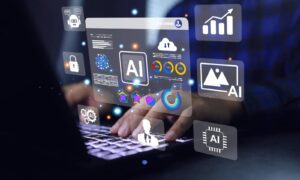It is a known fact that Americans spend far more on health care than anywhere else in the world but have the lowest life expectancy among large, wealthy countries. Part of this comes down to the amount of time doctors spend on carrying out administrative tasks, reducing the time they have for patients.
In the U.S., physicians spend an average of 16 minutes per patient completing electronic health records (EHRs). When multiplied across dozens of daily appointments, administrative tasks can take up a significant portion of a practitioner’s workday, contributing to burnout and reducing time available for direct patient care. In fact, physicians spend approximately 18.5 million hours on administration each year. It is considered one of the biggest sources of wasted medical spending.
Automating administrative tasks with GenAI offers a viable solution by reducing repetitive, manual data entry and improving documentation accuracy.
It works in following way:
GenAI-powered tools use what’s known as natural language processing (NLP) to transcribe and summarize conversations between patients and practitioners in real time. This eliminates the need for manual note-taking during consultations. Alternatively, doctors can continue to write handwritten notes and simply upload them onto a platform following an appointment.
Take Odesso’s platform, for example.
The Odesso platform uses large language models and does not require visual engagement which is drastically different from what was available a decade ago.
What this means is that when the platform receives information it can essentially act on its own – upload, transcribe, read, flag, all without the help of a human. Where the physician comes in is within the last 10% of the process where they must review the direction provided by the platform, determine next steps and take action. This 10% of the process is called Human in the Loop. The platform gets smarter and faster as usage increases similar to most machine learning tools.
In fact, thanks to Odesso, in 2024 over 350,000 patients received faster care.
This is a substantial improvement.
Some GenAI tools, like Odesso’s, can seamlessly integrate with existing EHR platforms, automatically updating patient files with minimal human intervention while ensuring compliance with regulatory standards.
Scalability for Underserved Areas
What’s more is that GenAI tools have the ability to completely transform health care in underserved areas of which there are many. According to the American Hospital Association it is estimated that 80% of rural America is “medically underserved,” meaning that a particular area has few primary care providers, high infant mortality rates, high poverty rates and an increasing number of patients who are age 65 or older.
GenAI tools can greatly support these areas, enhancing the productivity of smaller teams, easing the burden and pressure on healthcare providers and enabling facilities to treat their patients more effectively.
What it comes down to is that healthcare providers should not be unavailable to care for their patients due to burnout caused by the performance of administrative tasks. Transforming administrative tasks from manual to automated can open up resources, funding, and staff allowing the healthcare sector to take a big step in the right direction.



































